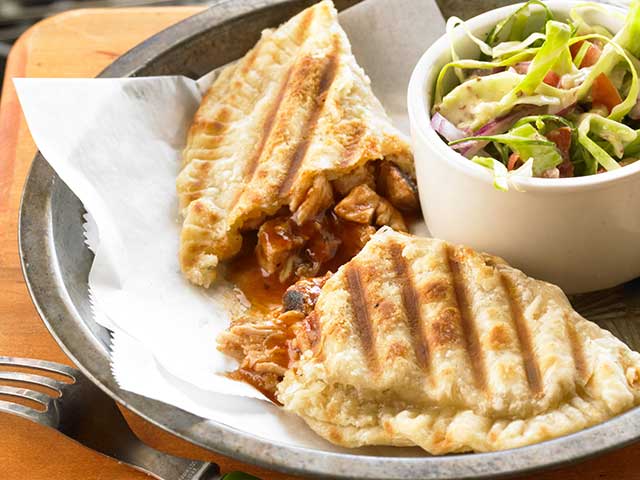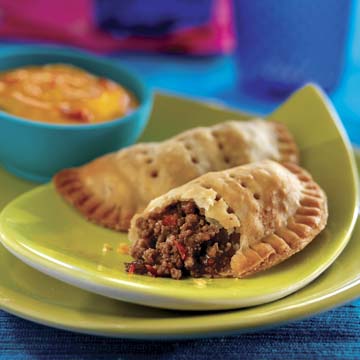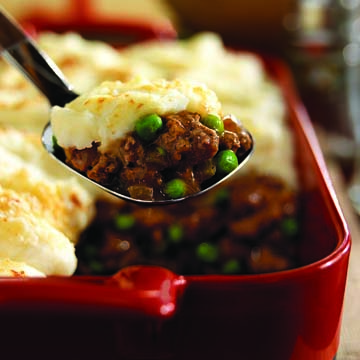It’s said that the word pie comes from magpie, a type of bird known for collecting and hording small items. In that way, a pie can be thought of as a collection of ingredients, secreted away inside a crust.
A pie is technically a dish with a baked filling topped with a crust. The top crust is usually pastry but can be another topping, such as biscuit or mashed potato (as in a shepherd’s pie).
Traditionally a pie, whether savory or sweet, has just a top crust. However, it can have a bottom crust, as in most American-style pies. And on the other hand, in Britain a sweet filling baked in just a shallow bottom crust is called a tart.
But our interest lies in those all-in-one meals, those warm-you-to-your-toes dishes, those comfort-food favorites: savory meat pies.

Grilled Pork Hand Pie. Photo courtesy of the National Pork Board. For more information visit porkbeinspired.com.
Hand Pies
In many countries, pies–particularly savory meat pies–are baked without any dish and the filling is entirely encased in crust. These hand-held meals are particularly popular as street vendor fare worldwide because of their portability.
Pasties
In Britain, the Cornwall pasty is such an established local traditional food that it has gained Protected Geographical Indication status by the European Commission. It is thus legally defined as a hand pie that is a semi-circle D-shaped pie with a crimped edge, and it contains a chunky filling of beef, potato, onion, turnips, and salt and pepper.
Outside of Britain, pasties are also popular wherever Cornish miners migrated, taking their favorite dish with them to their new homes. Therefore, the pies are found in many former colonies and British Commonwealth countries, such as Australia (which hosts an annual pasty festival), New Zealand, and South Africa. Additionally, in the United States, pasties are popular in Michigan’s Upper Peninsula, area of Wisconsin and Montana, and northeast Pennsylvania.
Empanadas
From the Spanish word empanar, which means to wrap or coat in bread, an empanada is a hand-pie that originated in Spain with a seafood filling. These tasty portable meals are now found in virtually every Spanish-speaking country worldwide, with variations abounding. Ingredients vary by region, with the outer “wrap” ranging from a corn dough to a flaky flour pastry. And fillings can include local meats or fish, cheeses, seasonings, or vegetables, and some regions even have sweet empanada filled with dulce de leche, local fruits like guava and pineapple, or jelly.
Other Ethnic Variations
As you can see, a portable meal wrapped in a pastry casing is hardly a unique culinary occurrence. Most cultures around the world have some form of this cuisine with their repertoires. Samosa hail from India. There are Brazilian pastel. Indonesian panada are filled with tuna and chili peppers. In Jamaica, they are known as meat patties and often feature curried beef with blazing Scotch bonnet peppers. And the cuisine of many African countries such as Ghana and Nigeria include hand pies that are simply called “meat pies.”

Beef Empanada
Shepherd’s Pie
Tracing its 18th century origins to the British Isles, Shepherd’s Pie is a humble dish, born of frugality. Early on it was called Cottage Pie, consisting of stewed ground meat (usually left over roast), potatoes, carrots, and peas combined in a rich gravy, topped with a thick layer of mashed potatoes, then put in a hot oven to warm the contents and brown the potato topping.
About 1870, the name Shepherd’s Pie was coined, though there weren’t any real differences in ingredients or method of preparation. At that time, one variation was to use the mashed potatoes to line the pan before filling it with meat and vegetables. Today, they are most often a topping only.
The biggest debate is whether to use ground beef or ground lamb. Some argue that lamb is the more appropriate ingredient, given that shepherds tend flocks of sheep, not herds of beef cattle.
And although beef was original to Cottage Pie, either is acceptable nowadays for Shepherd’s Pie. In fact, the essential recipe works well with just about any type of ground meat or poultry—even ham or sausage.

Shepherd’s Pie
Pot Pie
Perhaps the most simple and straight-forward variation, a pot pie is just a simple, savory pie in the traditional sense. A British pie consists of a filling baked in a deep dish with a crust on top. According to Larousse Gastronomique, “The traditional pie dish has a wide rim on which to place a strip of pastry to which the top crust can be attached once the filling is in place.”
According to this French culinary tome, common types of savory pie include chicken, steak and kidney, game, pork and apple, buffalo and beef, oyster, clam, and salmon. Perhaps most common in modern-day American cuisine are beef and chicken pot pies, consisting of a stew-like filling of beef or chicken, gravy, and vegetables, with a pastry lid and sometimes a pastry base as well.
It is a filling, stick-to-your-ribs. home-style comfort food that is best enjoyed during cold and dreary months.

Photo courtesy of the National Pork Board. For more information visit porkbeinspired.com.
Recipes
Beef Stew Topped with Black Pepper Biscuit Crust
What is your favorite type of meat pie? What ingredients do you prefer? Which ethnic or regional variations have you had?



Leave Your Response